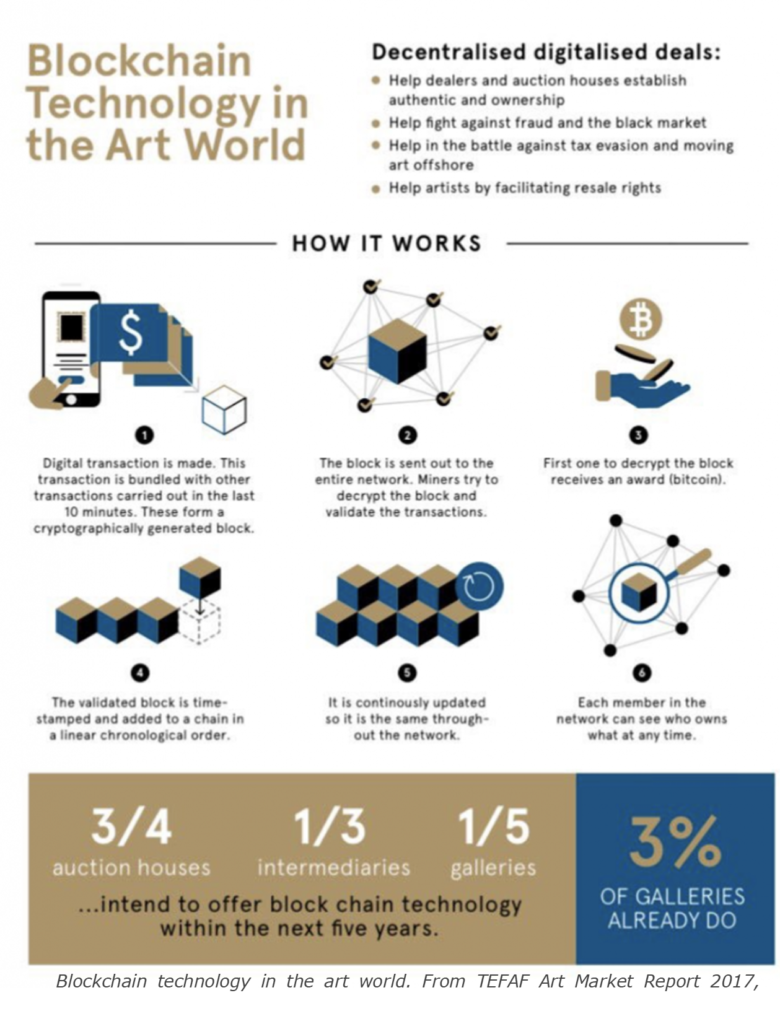
I like the guys at Ant Group. I like what they are doing with tech. This was featured heavily in Digital Human, and the company have continued to innovate ever since, most recently with AntChain. AntChain promotes the use of blockchain and have found several sweet spots for this technology that I haven't seen in Europe or America. By way of example, here's a special feature article by Felix Hamilton ...
How Blockchain is Transforming the Art World
by Felix Hamilton
Everything in the world is becoming increasingly digitised. The art world, traditionally slow to jump on new trends, is also evolving and the adoption of blockchain technology could have the power to transform the industry in ways that we have never seen before.
One of the art market’s greatest challenges, for works where the artist is no longer alive, is to verify its authenticity and provenance. Thus, when it comes to selling artwork there are two things that are important: is the piece of artwork real and does the seller have the authority to sell it? Problems have particularly arisen where the artist’s foundations have been unable to authenticate their own works.
Therefore, the introduction of distributed ledger technology (DLT) is a key for many, who believe it will have the greatest impact in proof and provenance. The technology allows everyone to share a ledger, sometimes with permission and sometimes as a public decentralised list of records. These records are linked and secured using cryptography and the key feature of DLT is its fragmented nature. Hosted by millions of computers simultaneously, no centralised version of the information exists for a hacker to access or corrupt. Thus, it is believed to be the most secure way to transfer digital data, particularly as it can track and trace any transaction made online anywhere, anytime by anyone.
The technology will help to solve and broaden the market’s issues and concerns around transparency, track ownership and provenance, and provide an infrastructure for the tokenisation of art, artists and fractional artwork sales. This is the reason why Non-Fungible Tokens (NFTs), commonly known as digital collectibles in China, have become big news in 2021, as NFTs are based on distributed ledger technology (DLT).
Why mention China? Because it is a nation that has embraced digital technologies like no other, particularly for art and antiques. For example, over the past decade, some of the largest art museums and institutions have taken impressive leaps to adopt these innovations to engage by developing a strong digital presence. For example, The Palace Museum in Beijing offers virtual tours of past and current exhibitions on their website. In fact today, according to Xinhua, over 2,000 museums in China offered digital exhibitions online during 2020, drawing over 5 billion visitors. The Hubei Provincial Museum in central China even digitised a famous sword from the Yue Kingdom and sold 10,000 digital pieces of the sword. The digital sword is with a 3D model and allows the buyer to zoom in and see the fine details, as well as rotate it.
One company specifically pioneering in this field is AntChain, the technology brand under the Ant Group. In October 2021, AntChain officially launched the ‘Treasure Project’, using blockchain technology to help the cultural and tourism industries promote the development of traditional culture with digital collectibles. AntChain is currently working with many museums and galleries to deploy this technology, including the Forbidden City’s Palace Museum, Hunan Provincial Museum and Chengdu Museum, to digitise their valuable assets. They will integrate innovative technologies such as 3D modelling, Augmented Reality and the Internet of Things (IoT) to give customers a more interactive experience, enabling them to engage with the digital art.
In the meantime, Alipay itself is the mobile payment platform and has also been instrumental in enhancing the services that museums offer. Around 2,000 museums in China have set up their own mini programs within the Alipay app offering more services, such as museum visit bookings and buying items from the museum souvenir shop.
In conclusion, new digital technologies are transforming the museum sector and attracting a swathe of new customers, due to their engaging digital exhibits and interactive experiences. The innovation will never stop, and the future is looking more accessible and secure.
Chris M Skinner
Chris Skinner is best known as an independent commentator on the financial markets through his blog, TheFinanser.com, as author of the bestselling book Digital Bank, and Chair of the European networking forum the Financial Services Club. He has been voted one of the most influential people in banking by The Financial Brand (as well as one of the best blogs), a FinTech Titan (Next Bank), one of the Fintech Leaders you need to follow (City AM, Deluxe and Jax Finance), as well as one of the Top 40 most influential people in financial technology by the Wall Street Journal's Financial News. To learn more click here...


